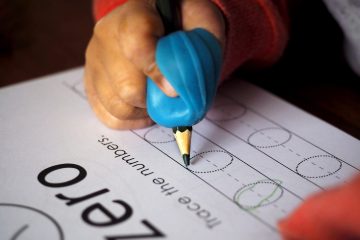Guest post from PrimaryLearning.org

Even with the increasing use of technology, many people believe that it continues to be important for children to learn cursive handwriting. The argument can be made that even if one doesn’t believe it’s necessary for children to write in cursive, it’s still important for them to be able to read cursive. Because reading and writing are reciprocal processes, learning to write in cursive will then help a child to read cursive.
When teaching children how to write in cursive, it is beneficial to introduce letters in a logical sequence. This means that it’s not necessary to start with the letter “a” and continue introducing letters in alphabetical order until “z” is reached. Instead, it is helpful to group letters together that require a similar pathway in order to be formed. For example, imagine writing the letters “i,” “t,” “u,” and “w.” Our pens start at the bottom, climb vertically, then return to the bottom. This pathway is the common starting point for all four letters, with variations occurring after these first steps. It makes sense to master this pathway before, for example, introducing a letter like “o” or “s.” The Zaner-Bloser Cursive Handwriting Order, is a helpful tool when determining which letters to introduce to children.
Once a plan is in place for introducing cursive letters, the next step is to provide practice. It’s important to begin with modelling, followed by guided practice, and leading to independent practice. Modelling allows children to see firsthand how the pencil moves to form the letters. Guided practice can take the form of tracing cursive letters, being mindful of the direction the pencil moves. Lastly, independent practice allows children to write the letters without a template to trace.
The next step in learning to write in cursive is joining the letters together. The links above contain worksheets that provide practice with this skill. Children are provided with the opportunity to trace words before writing them independently. Practice with linking letters together is important since there is variation in how the connections are made. For example, linking the letter “b” and linking the letter “d” are very different.
During this stage of handwriting practice, children see how individual words look when written in cursive and learn how to use spacing to separate words. It is during this stage that children can begin learning how to read words that are written in cursive.
It’s important to note that while children are learning to write in cursive, the focus should not be on speed. Instead, children are learning to follow the proper pathways to form the letters correctly. Next, they are trying to remember those pathways so they can write independently. It is only after children can form the letters properly and from memory that their speed may begin to increase.
As children become more proficient writing in cursive, they can begin focusing more on reading cursive handwriting. It will be necessary to expose them to cursive writing, written legibly, that they can practise reading. In these early stages, it will be helpful to use cursive writing that has properly formed letters, as opposed to someone’s signature style that varies from what children have learned. Once they are more confident reading cursive writing, they will be able to transfer their knowledge to other styles of handwriting. With continued practice, some children may choose cursive as their preferred method of writing.
Alesia is a founder of PrimaryLearning.org, an educational website that helps elementary school teachers and homeschool parents with hands-on worksheets, activities and thoughtful articles.


